- Author Jason Gerald [email protected].
- Public 2023-12-16 10:50.
- Last modified 2025-01-23 12:04.
One of the keys to a successful speech is delivering the closing remarks at the last minute. You can wow your audience by learning basic techniques for making good conclusions and creative ways to close your speech. Also, make sure you know what to avoid when giving a speech.
Step
Method 1 of 3: Closing Speech
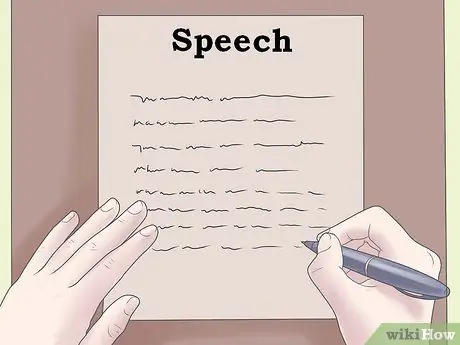
Step 1. Present a summary of the important information you explained during your speech
The main purpose of delivering a closing remark is to remind the audience of the important things they learned while listening to the speech. The introduction contains an explanation of the topic to be discussed, the body contains detailed speech material, and the closing remarks are useful for conveying the main idea last time.
- If needed, end the speech by reiterating the topic of the speech. What is the most important issue in a speech that the audience needs to remember? What did they learn after hearing the speech?
- When you close your speech in an informal setting, you don't need to convey the main idea again. If you're hosting a friend's wedding, don't waste time telling a long list of the groom's accomplishments.
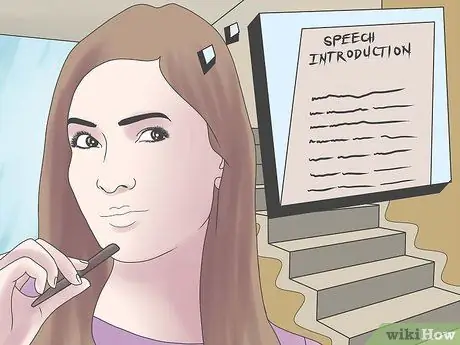
Step 2. Finish the speech by saying something memorable
Usually, the closing remarks re-express the main idea that was conveyed in the introduction to let the audience know that the speech is complete. If you provided an example or case study as a reference in the introduction, reiterate the example in the conclusion. This step can be a surefire tip to complete a speech that is useful for the audience.
- For example, if you opened your speech by telling a bleak picture of the life of a veteran who had just returned from the battlefield because he couldn't find a job or have health insurance and so his life was miserable, you'd be delivering a heartbreaking introduction. Retell this story in the closing remarks and tell what the living conditions of the veteran are like today so that the audience feels called to do something.
- Take advantage of references when closing the speech. If you start your speech by quoting Tan Malaka's words, end your speech by conveying information about Tan Malaka. This method is a surefire trick to signal to the audience that the speech is over.
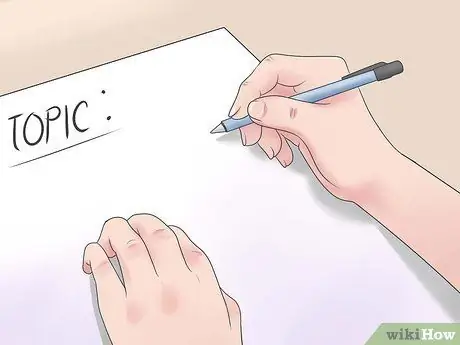
Step 3. Illustrate that the topic of the speech is a very important issue
During your speech, it's okay to go into detail about a particular event, but closing remarks can be a good opportunity to emphasize that the topic of your speech is very important. Depending on the purpose of the speech, if you are discussing the issue of global warming in detail, use the closing remarks to convey the results of studies or personal experiences to support the information you just conveyed so that the speech is useful for the audience.
- Help the audience understand the speech material. The results of studies and personal experiences are very effective in helping the audience understand complex information or topics.
- Some people use this method when delivering an introduction, but it's often not very useful. To be more effective, wait until you deliver your closing remarks, especially if you are giving a short speech.

Step 4. Use important phrases taken from the title of the speech
If you've already written a speech with an attention-grabbing title, use phrases in the title to signal that the speech is almost over by repeating it over and over again, providing explanations, or discussing it at the end of the speech. Audiences will immediately remember the phrase when they hear it because it seems so important. This method is fine for the duration of your speech, but is most useful at the end of your speech.
For example, say to the audience, "We can stop ocean pollution and global warming. As the title of my speech suggests, we can still do something. Remember, it's never too late!"
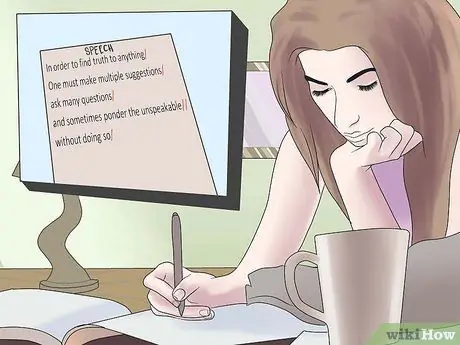
Step 5. Feel free to say the phrase, "In conclusion"
Many people feel confused when it comes to making conclusions. You do not need to draw conclusions by stringing beautiful words. If your speech is almost done, don't hesitate to say, "In conclusion" to signal that you want to close the speech. This way, your audience will know that you're almost done with your speech and that they need to get the gist of what you're saying.

Step 6. Thank the audience as a sign that the speech is over
One of the best ways to signal that you want to end your speech or remarks is to thank the audience for their attention and participation. Use this method as a transition to deliver a closing remark or final piece of information. Audiences tend to be more focused when they realize that a speech or welcoming speech is coming to an end.
- You need to say "thank you" as the last thing you say at the end of your speech. For example: "We must continue to fight against global warming for the sake of our children and grandchildren, our lives, and ourselves. Thank you". Usually, the audience applauds at the end of the speech.
- If there is still time, give the opportunity to ask the audience. Make sure the audience knows that you've finished your speech, but if they seem hesitant, you can say, "If you have any questions, I'm welcome."
Method 2 of 3: Ending the Speech

Step 1. Speak a little slower
One effective way to grab the audience's attention and convey the most important information is to slow down the tempo so that you speak very slowly. Say it word by word by pausing and pausing after you say a certain word to emphasize the main idea one last time. If someone arrives late, he can understand the speech material even if he only had time to listen to this part.
For example: "The struggle against global warming (pause) is an effort (pause) that demands persistence (pause) for the life (pause) of our children and grandchildren (pause) and all living things."
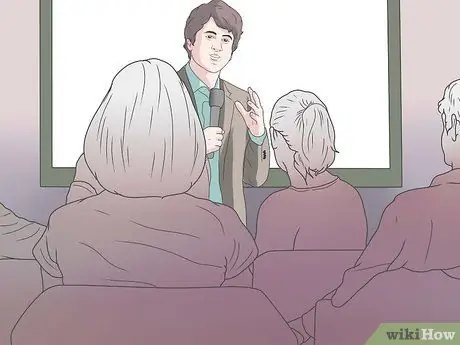
Step 2. End the speech with optimistic words
If you've just recounted a sad event or explained a procedure in detail, the best moment to lighten the mood by saying something positive is to close your speech. Your audience will re-energize if you remind them that things can be changed and problems can be solved.
Use stories about veterans struggling to find work. If he gets the support he needs in your speech, he may be able to engage in productive activities, own a private home, and spend his old age caring for plants in his yard. Tell your dream and then invite the audience to imagine it

Step 3. Use reps
Saying certain words or phrases over and over again is a great way to emphasize important information and end your speech by forming a new awareness. You can repeat certain phrases or say parallel sentences to close your speech using repetition.
- For example: "We must do this for our children and grandchildren. We must do this for our survival. We must do this for Indonesia. We must do this for the sake of nature conservation…"
- Another example: "Politicians can make laws that regulate this. Architects can design environmentally friendly buildings. Artists can compose songs containing messages about greening. Developers can make programs needed. You can make this happen".

Step 4. Get the audience into action
When giving a persuasive speech, you must provide a solution to the problem being discussed. For that, end the speech by explaining to the audience what they need to do right now for the changes to take place as you described in your speech. Show a slide with a phone number where you can be reached. Invite the audience to register on a particular website. Tell the audience how to contact parliamentarians who are competent in dealing with environmental pollution issues. If needed, engage the audience by asking them to sign the petition.
Interact with the audience. Use the word "you" when delivering your closing remarks or having a conversation with one of the participants for more effective interactions
Method 3 of 3: Avoiding Frequent Mistakes
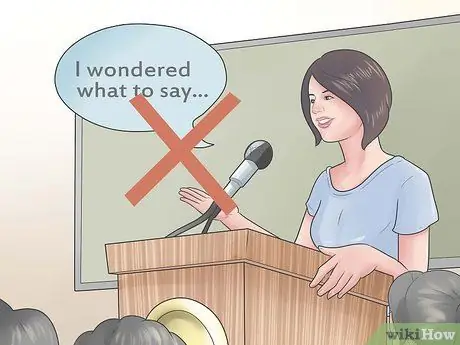
Step 1. Don't end the speech abruptly
The worst way to close a speech is to simply stop talking as if you were at a loss for words. Even if your speech is too long, take the time to close it as best you can with a simple closing remark. Don't just put the microphone down and then leave the podium. Avoid the following phrases or sentences when closing a speech:
- "It's enough to get here."
- "That's all I want to say."
- "Speech is over".

Step 2. Don't mess around
Make sure you deliver a prepared afterword. If you suddenly remember something you didn't say before closing your speech, don't speak spontaneously when it's time to conclude. The conclusion is the most important part of the speech. So, convey concise conclusions clearly and correctly, instead of being too long and verbose.
Don't continue speaking when you've finished your speech. Even if any information is missed, don't speak again while the audience is applauding or after. A closed speech means it is finished. If there is still time, continue with the question and answer session

Step 3. Don't apologize or demean yourself
Speaking in front of an audience is not easy, but don't make it difficult by discussing mistakes you made during your speech. If you think your speech is sluggish or too long, don't reveal the fact. This method is not useful because you will be exposing the worst things when closing the speech.
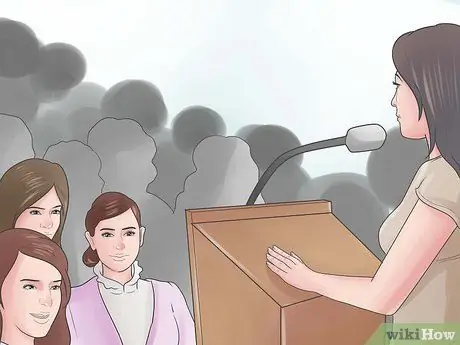
Step 4. Don't bring up new issues at the end of the speech
Closing your speech is an opportunity to conclude and remind you of the main idea, not to discuss a new issue. Even if you want to surprise or surprise, don't use the last minute to explain something that's hard to understand. Let the audience calm their minds and move on to something else.

Step 5. Do not convey conclusions that are not related to the material of the speech
If you are giving a speech about the dire situation of war, you do not need to ask the audience to contact someone or participate as a volunteer as this has nothing to do with the material of the speech. Don't give irrelevant afterwords as they will ruin everything you've been doing.
At times, the speech may end by telling a joke. If you're asked to deliver a welcoming speech at a wedding, tell a polite joke to lighten the mood. However, do not apply this step if you are giving a speech at a formal event
Tips
- Don't push yourself when writing a speech. After writing your first script, save it for a few days and then read it again from a different perspective as if you were listening to someone else give a speech. Read the script as if you were giving a speech and then start editing it.
- Try to grab the audience's attention by conveying surprising facts or statistics that get the audience intrigued and take immediate action.






